The AMD Zen and Ryzen 7 Review: A Deep Dive on 1800X, 1700X and 1700
by Ian Cutress on March 2, 2017 9:00 AM ESTConclusion
The march towards Ryzen has been a long road for AMD. Anyone creating a new CPU microarchitecture deserves credit as designing such a complex thing requires millions of hours of hard graft. Nonetheless, hard graft doesn’t always guarantee success, and AMD’s targets of low power, small area, and high-performance while using x86 instructions was a spectacularly high bar, especially with a large blue incumbent that regularly outspends them in R&D many times over.
Through the initial disclosures on the Zen microarchitecture, one thing was clear when speaking to the senior staff, such as Dr. Lisa Su, Mark Papermaster, Jim Anderson, Mike Clark, Sam Naffziger and others: that quiet confidence an engineer gets when they know their product is not only good but competitive. The PR campaign up until this point of launch has been managed (we assume) such that the trickle of information comes down the pipe and keeps people on the edge of their seat. Given the interest in Ryzen, it has worked.
Ryzen is AMD’s first foray into CPUs on 14nm, and using FinFETs, as well as a new microarchitecture and pulling in optimization methods from previous products such as Excavator/Carrizo and the GPU line. If we were talking tick-tock strategy, such as Intel’s process over the last decade, this is both a tick and a tock in one. Ryzen is the first part of that strategy, on the desktop processors first, with server parts coming out in Q2 and Notebook APUs in 2H17. One of the main concerns with AMD is typically the ability to execute – get enough good parts out on time and with sufficient performance to merit their launch. As Dr. Su said in our interview, it’s one big hurdle but there are many to come.
| AMD Ryzen 7 SKUs | ||||||
| Cores/ Threads |
Base/ Turbo |
L3 | TDP | Cost | Launch Date | |
| Ryzen 7 1800X | 8/16 | 3.6/4.0 | 16 MB | 95 W | $499 | 3/2/2017 |
| Ryzen 7 1700X | 8/16 | 3.4/3.8 | 16 MB | 95 W | $399 | 3/2/2017 |
| Ryzen 7 1700 | 8/16 | 3.0/3.7 | 16 MB | 65 W | $329 | 3/2/2017 |
Today’s launch of three CPUs, part of the Ryzen 7 family, will be followed by Ryzen 5 in Q2 and Ryzen 3 later in the year. Ryzen 7 uses a single eight-core die, and uses simultaneous multi-threading (SMT) to provide sixteen threads altogether, up to 4.0 GHz on the top Ryzen 7 1800X chip for $499. Officially AMD is positioning the 1800X as a direct competitor to Intel’s i7-6900K, an 8-core processor with hyperthreading that costs over $1000. In our benchmarks, it’s been clear that this battle goes toe-to-toe.
Analyzing the Results
In the brief time we had before getting a sample and this review, we were able to run our new benchmark suite on twelve different Intel CPUs, as well as AMD’s former APU crown holder, the A10-7890K. Throughout the discussion about Ryzen, AMD was advertising a 40%+ gain in raw performance per clock over their previous generations, which was then upped to 52% when the CPUs were actually announced. Back of the envelope calculations put Ryzen at the level of the high-end desktop Broadwell CPUs or just about, which means it would be a case of pure frequency. That being said, Intel is already running CPUs two generations ahead on its mainstream platform, such as the Kaby-Lake based i7-7700K, so it’s going to be an interesting analysis.
Multi-Threaded Tests
First up, AMD’s strength in our testing was clearly in the multithreaded benchmarks. Given the microarchitectures of AMD’s and Intel’s high-performance x86 cores are somewhat similar, for the most part there’s a similar performance window. Intel’s design is slightly wider and has a more integrated cache hierarchy, meaning it manages to win out on ‘edge cases’ that might be a result of bad code. As one might expect, it takes a lot of R&D to cater for particular edge cases.
But as a workstation-based core design, the Zen microarchitecture pulls no punches. As long as the software doesn’t need strenuous AVX code, and manages its memory carefully (such as false sharing), the performance of Ryzen in conventional multi-threaded CPU environments means AMD is back in the game. This is going to be beneficial for the Zen microarchitecture when we see it applied into server environments, especially those that require virtualization.
Single Threaded Tests
Since the launch of Bulldozer, AMD has always been a step behind on single-threaded performance. ST performance is a holy-grail of x86 core design, but often requires significantly advanced features that can potentially burn extra power to get there. AMD’s message on this, even in our interview with Dr. Su, is that AMD has the ability to innovate. This is why AMD promotes features such as SenseMI for their new advanced pre-fetch algorithms, why implementing a micro-op cache into the core was a big thing, and how having double the L2 cache over Intel’s comparable parts were important to the story. Nonetheless, AMD hammered down that a 40%+ IPC gain into its narrative, which then folded into a 52% gain at launch. We’ll take a deeper look into this in a separate review, but our single threaded results show that AMD is back in the fight.
Most of the data points in this graph come from Intel Kaby Lake processors at various frequencies, but the important thing here is that the Ryzen parts are at least in the mix, sitting above the other eight core parts on the far right of the graph. Also, the jump from the A10 up to the 1700 is a big generational jump, let alone considering the 1800X.
Overall Performance
Putting these two elements into the same graph gives the following:
By this measure, for overall performance, it’s clear the Core i7-7700K is still better in price/performance. However, AMD would argue that the competition for the Ryzen 7 parts is on the right, with the i7-6900K and i7-5960X. In our CPU-based results, AMD wins this performance per dollar hands down.
Some Caveats
Since testing this review, and waiting a few days to even write the conclusion, there has been much going on about ways in which AMD’s performance is perhaps being neutered. This list includes discussions around:
- Windows 10 RTC disliking 0.25x multipliers, causing timing issues,
- Software not reading L3 properly (thinking each core has 8MB of L3, rather than 2MB/core),
- Latency within a CCX being regular, but across CCX boundaries having limited bandwidth,
- Static partitioning methods being used shows performance gains when SMT is disabled,
- Ryzen showing performance gains with faster memory, more so than expected,
- Gaming Performance, particularly towards 240 Hz gaming, is being questioned,
- Microsoft’s scheduler not understanding the different CCX core-to-core latencies,
- Windows not scheduling threads within a CCX before moving onto the next CCX,
- Some motherboards having difficulty with DRAM compatibility,
- Performance related EFIs being highly regularly near weekly since two weeks before launch.
A number of these we are already taking steps to measure. Some of the fixes to these issues come from Microsoft’s corner, and we are already told that both AMD and Microsoft are underway to implement scheduling routines to fix these. Other elements will be AMD focused: working with software companies to ensure that after a decade of programming for the other main x86 microarchitecture, it’s a small step to also consider the Zen platform.
At this point, we’re unsure at what level some of these might be default design issues with Zen. The issue of single-thread performance increasing when SMT is disabled (we’ve done some pre-testing, up to 6% in ST) is clearly related to the design of the core, with static partitioning vs competitive partitioning of certain parts of the design. The CCX latency and detection is one that certainly needs further investigation.
The future according to Senior Fellow Mike Clark, one of the principle engineers on the Zen microarchitecture, is that AMD knows where the easy gains are for their next generation product (codenamed Zen 2), and they're already working through the list. A question is then if Intel continues at 5% performance gains clock for clock each year, can AMD make 5-15% and close the gap?
The Silver Lining
It is relevant to point out that Intel is on its 7th Generation of Core microarchitecture. Sure, it looks significantly different when it was designed, but software vendors have had seven generations to optimize for it. Coming in and breaking the incumbent’s stranglehold is difficult, when every software vendor knows that design in and out. While AMD’s design looks similar to Intel, there are nuances which programmers might not have expected, and so it might be a good couple of years before the programming guides have made their way through into production software.
But,
When we look at the CPU benchmarks as part of this review, which have a strong range in algorithm difficulty and dependency, AMD still does well. There’s no getting around that AMD has a strong workstation core design on their hands. This bodes well for users who need compute at a lower cost, especially when you can pick up an eight-core Ryzen 7 at half the cost of the competition.
This makes the server story for AMD, under Naples, much more interesting.
AnandTech Recommended Award
For Performance/Price on a Workstation CPU


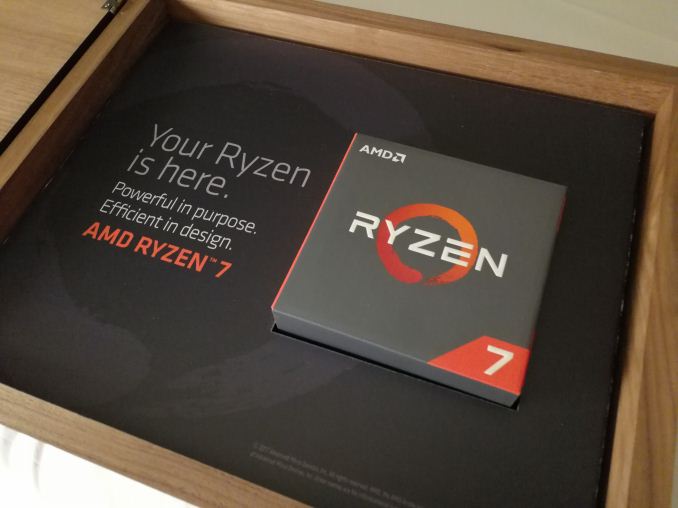
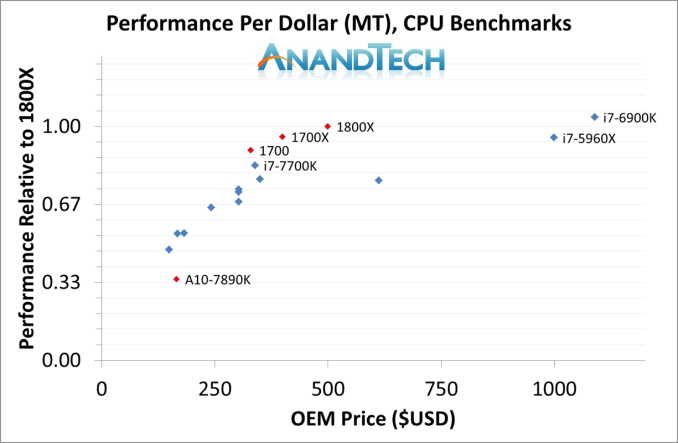
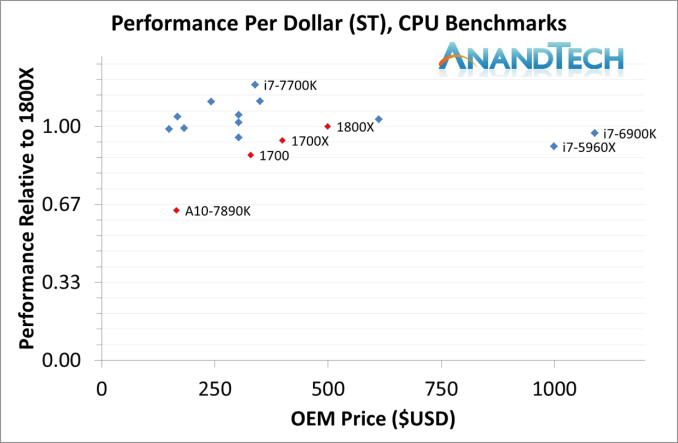
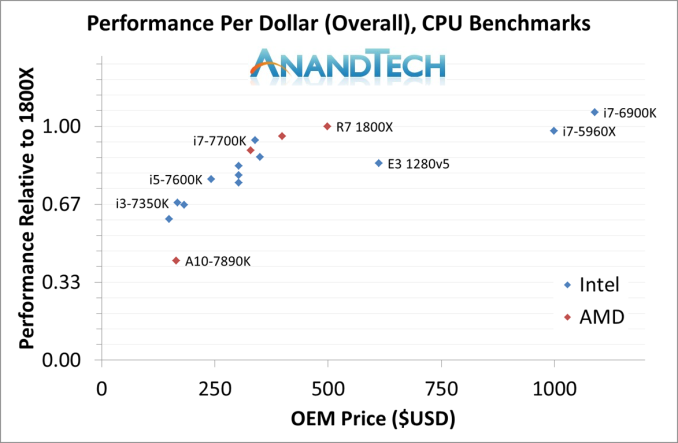
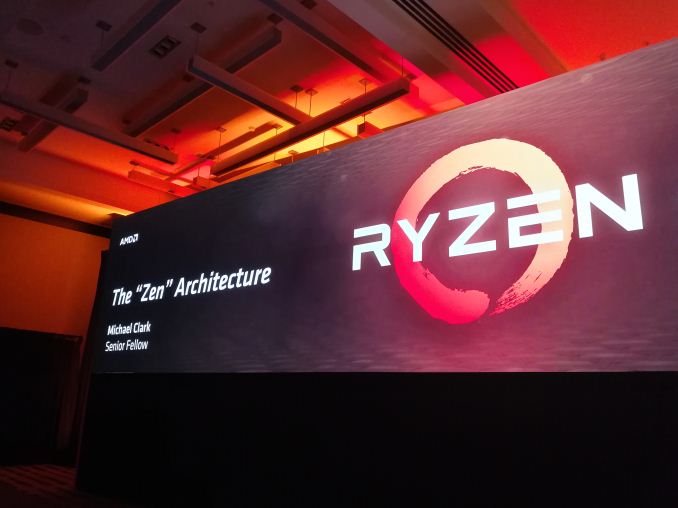

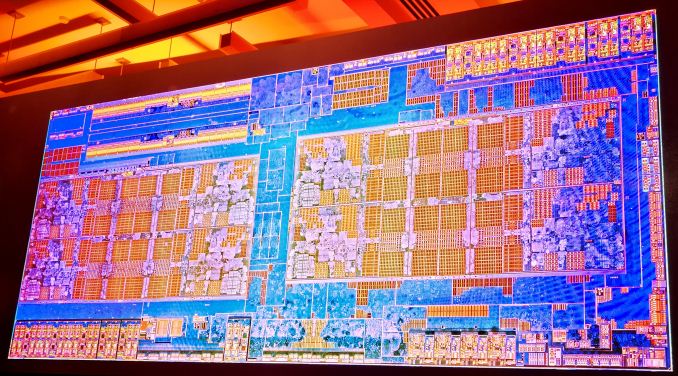








574 Comments
View All Comments
mapesdhs - Sunday, March 5, 2017 - link
If you have a Q6600, I can understand that, but the QX9650 ain't too bad. ;)Marburg U - Monday, March 6, 2017 - link
I'm on a Q9550 running at 3.8 for the past 6 years. I could still run modern games at 1050p, with a r9 270x, but that's the best i can squeeze out of it. Mind that i'm still on DDR2 (my motherboard turns 10 in a few months). I really want to embrace a ultra wide monitor.mapesdhs - Monday, March 6, 2017 - link
Moving up to 2560x1440 may indeed benefit from faster RAM, but it probably depends on the game. Likewise, CPU dependencies vary, and they can lessen at higher resolutions, though this isn't always the case. Still, good point about DDR2 there. To what kind of GPU were you thinking of upgrading? Highend like 1080 Ti? Mid-range? Used GTX 980s are a good deal these days, and a bunch of used 980 Tis will likely hit the market shortly. I've tested 980 SLI with older platforms, actually not too bad, though I've not done tests with my QX9650 yet, started off at the low end to get through the pain. :D (P4/3.4 on an ASUS Striker II Extreme, it's almost embarassing)Ian.
Meditari - Monday, March 6, 2017 - link
I'm actually using a Q9550 that's running at 3.8 as well. I have a 980ti and it can do 4k, albeit at 25-30fps in newer games like Witcher 3. Fairly certain a 1080ti would work great with a Q9550, but I feel like the time for these chips is coming to an end. Still incredible that a 8 year old chip can still hold it's own by just upgrading the GPUmapesdhs - Tuesday, March 7, 2017 - link
Intriguing! Many people don't even try to use such a card on an older mbd, they just assume from sites reviews that it's not worth doing. Can you run 3DMark11/13? What results do you get? You won't be able to cite the URLs here directly, but you can mention the submission numbers and I can compare them to my 980 Ti running on newer CPUs (the first tests I do with every GPU I obtain are with a 5GHz 2700K, at which speed it has the same multithreaded performance as a stock 6700K).What do you get for CB 11.5 and CB R15 single/multi?
What mbd are you using? I ask because some later S775 mbds did use DDR3, albeit not at quite the speeds possible with Z68, etc. In other words, you could move the parts on a better mbd as an intermediate step, though finding such a board could be difficult. Hmm, given the value often placed on such boards, it'd probably be easier to pick up a used 3930K and a board to go with it, that would be fairly low cost.
Or of course just splash for a 1700X. 8)
Ian.
Notmyusualid - Tuesday, March 7, 2017 - link
Welcome to the 21:9 fan club brother.But be careful of the 1920x1080 screens, my brother's 21:9 doesn't look half as good as my 3440x1440 screen.. It just needs that little bit more verticle resoultion.
My pals 4k screen is lovely, and brings his 4GB 980 GTX to its knees. Worse aspect ratio (in my opinion), and too many pixels (for now) to draw.
Careful of second-hand purchases too, many panels with backlight-bleed issues out there, and they are returns for that reason, again, in my opinion.
AnnonymousCoward - Monday, March 6, 2017 - link
Long story short:20% lower single-thread than Intel
70% higher multi-thread due to 8 cores
$330-$500
Mugur - Tuesday, March 7, 2017 - link
Actually, on average -6.8% IPC versus Kaby Lake (at the same frequency) - I believe this came directly from AMD. Add to this a lower grade 14nm process (GF again) that is biting AMD again and again (see last year RX480). Motherboard issues (memory, HPET), OS/application issues (SMT, lack of optimizations).All in all, I'm really impressed of what they achieved with such obstacles.
AnnonymousCoward - Tuesday, March 7, 2017 - link
Just looking at CineBench at a given TDP and price, AMD is 20% lower. That's the high level answer, regardless of IPC * clock frequency. I agree it's a huge win for AMD, and for users who need multicore performance.Cooe - Monday, March 1, 2021 - link
Maybe compare to Intel's Broadwell-E chips with actually similar core counts.... -_-